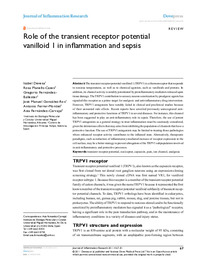Por favor, use este identificador para citar o enlazar este ítem:
https://hdl.handle.net/11000/36088Registro completo de metadatos
| Campo DC | Valor | Lengua/Idioma |
|---|---|---|
| dc.contributor.author | Devesa Giner, Isabel | - |
| dc.contributor.author | Planells Cases, Rosa | - |
| dc.contributor.author | Fernández-Ballester, Gregorio | - |
| dc.contributor.author | González Ros, José Manuel | - |
| dc.contributor.author | Ferrer-Montiel, Antonio | - |
| dc.contributor.author | Fernández Carvajal, Asia | - |
| dc.contributor.other | Departamentos de la UMH::Bioquímica y Biología Molecular | es_ES |
| dc.date.accessioned | 2025-03-24T10:49:26Z | - |
| dc.date.available | 2025-03-24T10:49:26Z | - |
| dc.date.created | 2011-05 | - |
| dc.identifier.citation | Journal of Inflammation Research , Volume 4, 2011 | es_ES |
| dc.identifier.issn | 1178-7031 | - |
| dc.identifier.uri | https://hdl.handle.net/11000/36088 | - |
| dc.description.abstract | The transient receptor potential vanilloid 1 (TRPV1) is a thermoreceptor that responds to noxious temperatures, as well as to chemical agonists, such as vanilloids and protons. In addition, its channel activity is notably potentiated by proinflammatory mediators released upon tissue damage. The TRPV1 contribution to sensory neuron sensitization by proalgesic agents has signaled this receptor as a prime target for analgesic and anti-inflammatory drug intervention. However, TRPV1 antagonists have notably failed in clinical and preclinical studies because of their unwanted side effects. Recent reports have unveiled previously unrecognized antiinflammatory and protective functions of TRPV1 in several diseases. For instance, this channel has been suggested to play an anti-inflammatory role in sepsis. Therefore, the use of potent TRPV1 antagonists as a general strategy to treat inflammation must be cautiously considered, given the deleterious effects that may arise from inhibiting the population of channels that have a protective function. The use of TRPV1 antagonists may be limited to treating those pathologies where enhanced receptor activity contributes to the inflamed state. Alternatively, therapeutic paradigms, such as reduction of inflammatory-mediated increase of receptor expression in the cell surface, may be a better strategy to prevent abrogation of the TRPV1 subpopulation involved in anti-inflammatory and protective processes | es_ES |
| dc.format | application/pdf | es_ES |
| dc.format.extent | 15 | es_ES |
| dc.language.iso | eng | es_ES |
| dc.publisher | Taylor and Francis Group Dove Press | es_ES |
| dc.rights | info:eu-repo/semantics/openAccess | es_ES |
| dc.rights | Attribution-NonCommercial-NoDerivatives 4.0 Internacional | * |
| dc.rights.uri | http://creativecommons.org/licenses/by-nc-nd/4.0/ | * |
| dc.subject | transient receptor potential | es_ES |
| dc.subject | nociceptor | es_ES |
| dc.subject | capsaicin | es_ES |
| dc.subject | pain | es_ES |
| dc.subject | ion channel | es_ES |
| dc.subject | analgesia | es_ES |
| dc.subject.other | CDU::5 - Ciencias puras y naturales::57 - Biología::577 - Bioquímica. Biología molecular. Biofísica | es_ES |
| dc.title | Role of the transient receptor potential vanilloid 1 in inflammation and sepsis | es_ES |
| dc.type | info:eu-repo/semantics/article | es_ES |
| dc.relation.publisherversion | https://doi.org/10.2147/JIR.S12978 | es_ES |

Ver/Abrir:
16_2011_Devesa_Jorunal of inflammation research_review.pdf
1,56 MB
Adobe PDF
Compartir:
 La licencia se describe como: Atribución-NonComercial-NoDerivada 4.0 Internacional.
La licencia se describe como: Atribución-NonComercial-NoDerivada 4.0 Internacional.
.png)